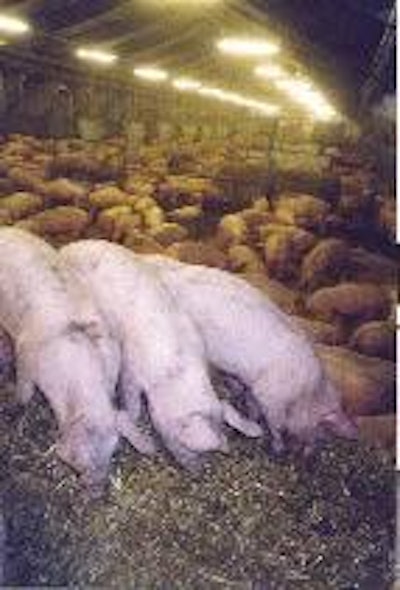
One day someone will solve the puzzle that is light. Such conflicting indications exist about the correct lighting to use in pig houses that producers typically receive little guidance apart from the old saying that there should be enough light to read a newspaper. In enclosed housing this is most often interpreted as justifying the use of background illumination for much of the day. For grow-out places the light intensity may be increased at feeding time and when the pigs are inspected, but even then perhaps only to a modest 50 lux. Many gestation facilities are similarly kept semi-dark except for a short boost to around 150 lux when checking sows on returns to oestrus.
Near-darkness is also a nearly normal condition for the farrowing house in most countries. Almost the only glow may be from the heat lamps. But there are clues in favour of allowing more light in lactation. The latest information in Europe makes an even stronger case for illuminating the pens used by the sow herd for mating or insemination.
Testing light intensities on sows
A research station near Berlin in northern Germany has circulated the results of its test comparing light intensities in the Eros Centre where sows were housed from weaning until they had been inseminated artificially. Lighting levels ranged from dark to bright. The team from the Brandenberg station at Teltow-Ruhlsdorf monitored the sows afterwards to assess whether these differences in the insemination area went on to affect litter size at the next farrowing.
Pig numbers were much the same for litters from AI in a bright or moderately lit environment. By contrast, the poorest figures came from keeping sows in the dark after weaning.
Also, the light intensity quoted for each group was in fact an amalgam of measurements at 6 levels in the house. Intensity values do depend on proximity to the light source. They can drop quickly only a short distance from the lamp and they are also, of course, changed by the shadows cast by equipment. Universal advice for the sow house is to place lamps over the sows' heads and to avoid locating items such as feeders so that the face of the animal is in shadow.
Twenty years ago there was another German report about the effect of light intensity on fertility in sows, points out Professor Steffen Hoy at the University of Giessen in Germany. The 1986 publication revealed fewer sows to have returned to oestrus where the insemination area contained artificial light. Professor Hoy's own PhD thesis had also examined the influences of light on pigs such as by a trial in 1979, repeated in 1981, checking female meat pigs at slaughter for their development of ovaries and uterus. Considerably fewer of the gilts grown in pens with a low 50 lux of artificial light for 14 hours/day showed these signs of reproductive maturity, compared with others on 80 lux for 8 hours or 14 hours daily.
Although practical information is still in short supply about the impact of the light regime on the fertility of sows, Prof. Hoy remarks, modern results go in the same direction as those of years ago when they suggest that a certain level of illumination is desirable for the area where sows are inseminated. The current recommendation he makes is that providing the sows with a light intensity of 150-300 lux for 14 hours daily leads to an increase in their rate of conception and litter size.
Some more detail is needed to avoid misunderstanding. The lux intensity mentioned is that from a single measurement taken directly below the fluorescent lamp. It could be supplied by placing a 58-watt cool-white fluorescent lamp above every 2-3 individual sow places in the insemination zone, assuming that the lamp was at a height of 1.5 metres over the sows' heads.
Most other specialists similarly advise the use of white fluorescent lamps rather than incandescent bulbs to provide the artificial lighting, mainly on the basis that they are cheaper to operate. A single 58W fluorescent lamp 150cm long gives as much light as 4 bulbs of 100W. To supply 300 lux could need 150-watt bulbs every 1.5 metres across the building, whereas the equivalent intensity would come from tubes placed only at every 4 metres of house width.
Whatever the type, all sources of advice underline the importance of keeping lights clean. Measurements have shown that dirt on a light-bulb can reduce its brightness by 25% or more. In practice, light intensity tends to reduce gradually through a steady accumulation of fly faecal matter and dust on the surface of the lamp. Also emphasised everywhere is to choose lighting equipment that can be washed and resists corrosion. Painting internal house surfaces white or another light colour will increase the amount of reflection they provide.
The colour of the equipment in a room might be another factor to consider. Extra lights were added to a new European sow house last year, although the original illumination had met the specifications laid down when the house was built, after attendants found the conditions too dark. The difficulty was thought to relate to the dark red chosen as the paint for some of the pen equipment. This colour had the apparent effect of absorbing some light so that the people working in the compartments found them relatively dim.




.jpg?auto=format%2Ccompress&fit=crop&h=167&q=70&w=250)












